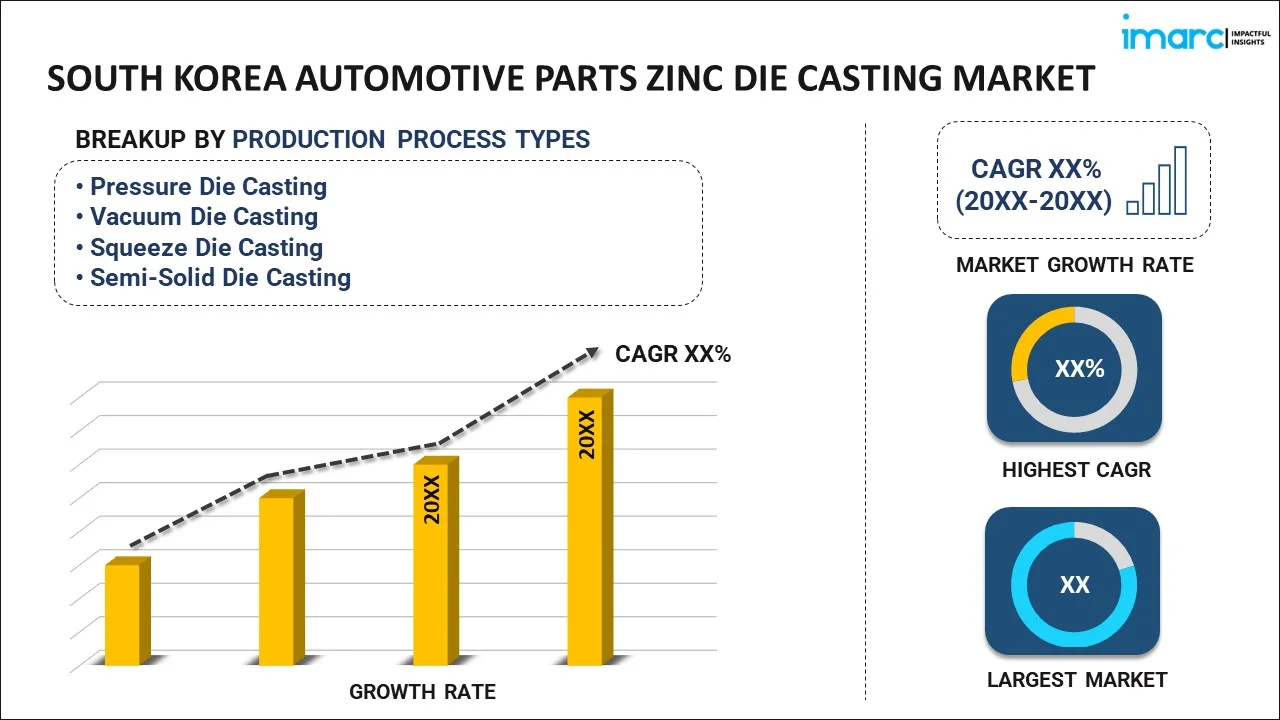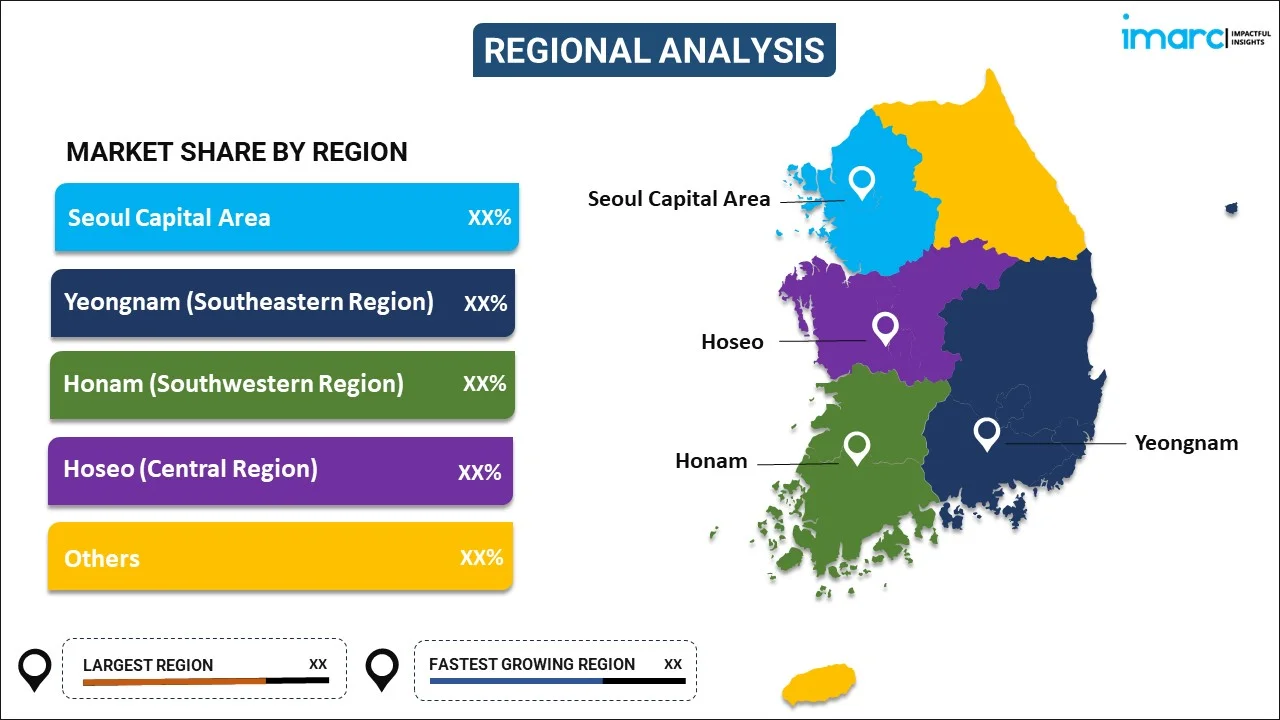
South Korea Automotive Parts Zinc Die Casting Market Report by Production Process Type (Pressure Die Casting, Vacuum Die Casting, Squeeze Die Casting, Semi-Solid Die Casting), Application Type (Body Assembly, Engine Parts, Transmission Parts, and Others), and Region 2025-2033
Market Overview:
South Korea automotive parts zinc die casting market size reached USD 863.4 Million in 2024. Looking forward, IMARC Group expects the market to reach USD 1,103.6 Million by 2033, exhibiting a growth rate (CAGR) of 2.76% during 2025-2033. The country's thriving automotive manufacturing sector, the escalating demand for lightweight and durable components, stringent regulations on emissions and fuel efficiency, cost-effectiveness of zinc die casting, availability of skilled labor force, and the rise of electric vehicles are propelling the market growth.
|
Report Attribute
|
Key Statistics
|
|---|---|
|
Base Year
|
2024
|
|
Forecast Years
|
2025-2033
|
|
Historical Years
|
2019-2024
|
| Market Size in 2024 | USD 863.4 Million |
| Market Forecast in 2033 | USD 1,103.6 Million |
| Market Growth Rate 2025-2033 | 2.76% |
Automotive parts zinc die casting is a manufacturing process that involves the precision casting of metal components, primarily using zinc alloy as the base material. It relies on the use of molds or dies to produce intricate and complex shapes with a high degree of accuracy. The process begins with the melting of the zinc alloy, typically composed of zinc, aluminum, and copper, to a specific temperature. Once molten, the alloy is injected into the pre-designed molds under pressure, allowing it to cool and solidify. The automotive industry extensively utilizes zinc die casting for various components, such as engine parts, transmission housings, door handles, and decorative trim. The advantages of this method include cost-effectiveness, as it allows for mass production with minimal waste, high-speed production capabilities, and the ability to produce parts with thin walls and fine details. Additionally, zinc die casting offers excellent corrosion resistance and durability, ensuring the longevity of automotive components. Currently, there are two primary types of zinc die casting: hot chamber and cold chamber. Hot chamber die casting is suitable for zinc alloys with low melting points and involves the direct injection of molten metal into the mold. Cold chamber die casting, on the other hand, is utilized for alloys with higher melting points and employs a ladle to transfer the molten metal into the mold.
South Korea Automotive Parts Zinc Die Casting Market Trends:
The South Korea automotive parts zinc die casting market is influenced by several key drivers, such as the country's rapidly expanding automotive industry. In line with this, the increasing demand for lightweight and durable automotive components is driving the market growth. Furthermore, stringent regulations pertaining to fuel efficiency and emissions have led to the need for advanced materials, which is fueling the market growth. Additionally, the increasing recognition of zinc die casting as a cost-effective manufacturing process is another significant catalyst driving market growth. Moreover, the growing trend of electric vehicles (EVs) and the emphasis on quality and precision in manufacturing processes are propelling the market growth. Other factors, such as the country's skilled labor force and advanced technology infrastructure, are providing a positive environment for the market growth across the country.
South Korea Automotive Parts Zinc Die Casting Market Segmentation:
IMARC Group provides an analysis of the key trends in each segment of the market, along with forecasts at the country level for 2025-2033. Our report has categorized the market based on production process type and application type.
Production Process Type Insights:

- Pressure Die Casting
- Vacuum Die Casting
- Squeeze Die Casting
- Semi-Solid Die Casting
The report has provided a detailed breakup and analysis of the market based on the production process type. This includes pressure die casting, vacuum die casting, squeeze die casting, and semi-solid die casting.
Application Type Insights:
- Body Assembly
- Engine Parts
- Transmission Parts
- Others
A detailed breakup and analysis of the market based on the application type have also been provided in the report. This includes body assembly, engine parts, transmission parts, and others.
Regional Insights:

- Seoul Capital Area
- Yeongnam (Southeastern Region)
- Honam (Southwestern Region)
- Hoseo (Central Region)
- Others
The report has also provided a comprehensive analysis of all the major regional markets, which include Seoul Capital Area, Yeongnam (Southeastern Region), Honam (Southwestern Region), Hoseo (Central Region), and others.
Competitive Landscape:
The market research report has also provided a comprehensive analysis of the competitive landscape in the market. Competitive analysis such as market structure, key player positioning, top winning strategies, competitive dashboard, and company evaluation quadrant has been covered in the report. Also, detailed profiles of all major companies have been provided.
South Korea Automotive Parts Zinc Die Casting Market Report Coverage:
| Report Features | Details |
|---|---|
| Base Year of the Analysis | 2024 |
| Historical Period | 2019-2024 |
| Forecast Period | 2025-2033 |
| Units | Million USD |
| Scope of the Report | Exploration of Historical and Forecast Trends, Industry Catalysts and Challenges, Segment-Wise Historical and Predictive Market Assessment:
|
| Production Process Types Covered | Pressure Die Casting, Vacuum Die Casting, Squeeze Die Casting, Semi-Solid Die Casting |
| Application Types Covered | Body Assembly, Engine Parts, Transmission Parts, Others |
| Regions Covered | Seoul Capital Area, Yeongnam (Southeastern Region), Honam (Southwestern Region), Hoseo (Central Region), Others |
| Customization Scope | 10% Free Customization |
| Post-Sale Analyst Support | 10-12 Weeks |
| Delivery Format | PDF and Excel through Email (We can also provide the editable version of the report in PPT/Word format on special request) |
Key Questions Answered in This Report:
- How has the South Korea automotive parts zinc die casting market performed so far and how will it perform in the coming years?
- What has been the impact of COVID-19 on the South Korea automotive parts zinc die casting market?
- What is the breakup of the South Korea automotive parts zinc die casting market on the basis of production process type?
- What is the breakup of the South Korea automotive parts zinc die casting market on the basis of application type?
- What are the various stages in the value chain of the South Korea automotive parts zinc die casting market?
- What are the key driving factors and challenges in the South Korea automotive parts zinc die casting?
- What is the structure of the South Korea automotive parts zinc die casting market and who are the key players?
- What is the degree of competition in the South Korea automotive parts zinc die casting market?
Key Benefits for Stakeholders:
- IMARC’s industry report offers a comprehensive quantitative analysis of various market segments, historical and current market trends, market forecasts, and dynamics of the South Korea automotive parts zinc die casting market from 2019-2033.
- The research report provides the latest information on the market drivers, challenges, and opportunities in the South Korea automotive parts zinc die casting market.
- Porter's five forces analysis assist stakeholders in assessing the impact of new entrants, competitive rivalry, supplier power, buyer power, and the threat of substitution. It helps stakeholders to analyze the level of competition within the South Korea automotive parts zinc die casting industry and its attractiveness.
- Competitive landscape allows stakeholders to understand their competitive environment and provides an insight into the current positions of key players in the market.
Need more help?
- Speak to our experienced analysts for insights on the current market scenarios.
- Include additional segments and countries to customize the report as per your requirement.
- Gain an unparalleled competitive advantage in your domain by understanding how to utilize the report and positively impacting your operations and revenue.
- For further assistance, please connect with our analysts.
 Inquire Before Buying
Inquire Before Buying
 Speak to an Analyst
Speak to an Analyst
 Request Brochure
Request Brochure
 Request Customization
Request Customization




.webp)




.webp)












